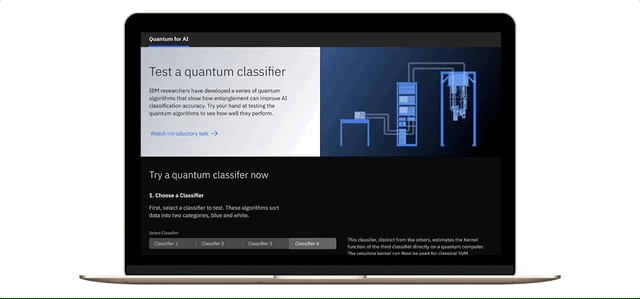Representation of data path for the quantum computing classification experiments
Quantum for AI
UX Design / Science Communication (2018-19)
Quantum for AI is an interactive demo developed for the NIPS 2018 conference that allows people to test the performance and accuracy of quantum classification algorithms developed by IBM researchers. I led a 6-person design + development team to create an interactive experience that would allow technology enthusiasts and the general public to explore quantum classification. Our goals were the following —
A person needed to have a meaningful interaction within one minute of arriving to the demo, and remain engaged enough to stay longer
The research shown in the demo should be reflected clearly and accurately
No prior knowledge of quantum computing or AI should be required to enjoy the demo
Initial Prototype
We were given one week to build a fully functional prototype, as part of an internal IBM Research hackathon. I was tasked with reading relevant publications and working with the science team to develop an engaging and easy to understand narrative around the research, while my development team examined what was data feasible to generate with the quantum classification algorithms in the limited time available.
Initial concept sketches were created in the collaborative online design tool Figma
Notes in Figma on the four classifier versions that motivated our final concept and design
After iterating and testing a few different concepts, we converged on a demo that would allow people cycle between four different versions of the quantum classifiers, and then test each classifier’s performance. This setup would allow people to interact with the quantum component of the Quantum + AI demo — the classifiers themselves — while observing first-hand that as the quantum complexity of the classifier increased, so too does its accuracy.
Initial user experience flow of hackathon demo prototype, built in sketch and tested with users with Invision
Based on this concept, I created a clickable UX prototype to demonstrate intended user flows and functionality to the development team. I then worked with the researchers and IBM’s Communications team to develop a narrative and visual graphics to provide context and clear calls to action for the demo contents. Our final coded prototype won first place in the IBM AI Hackathon and earned a spot at IBM’s NIPS 2018 demo booth.
Final NIPS Demo Design
To ready the demo for NIPS, I collaborated with the team visual designer to update the layout, aesthetic, and visual assets to match IBM’s design branding guidelines.
Final design for NIPS 2018 demo
The final demo consists of four major sections —
An introductory section provides a broad overview of the demo’s contents and the value of the research conducted, with links to an external talk on the subject matter.
The interactive demo allows users to immediately start engaging with the research without getting bogged down by upfront exposition. Users can select each of the four classifiers developed by the research team and test them to compare the performance of the classifier with its initial training set.
An explanatory section provides additional context about the quantum classifiers, how they are implemented, and what makes the experimental results compelling.
A concluding section summarizes the potential impact of quantum AI applications more broadly, and provides relevant calls to action for those who wish to learn more or start working with the open-source python framework used in this research.
The final demo went live on December 1st as part of IBM’s AI Research Showcase for NIPS 2018. In March of 2019, a version of the demo was made live on the IBM Research AI website, so that the experience could be enjoyed by the general public.
To learn more and try the live demo, visit:
https://ibm-q4ai.mybluemix.net/


